Engaged Scholar
Social Disparities and Inequality

Some groups in society have disadvantages based on their race, gender, and class. This has created great income inequalities and fewer opportunities for these groups. The University of Memphis’s mission is to be a learner-centered university providing high quality educational experiences while pursuing new knowledge through research, artistic expression, and interdisciplinary and engaged scholarship. To advance this mission, all participants within the learning context should be aware of and recognize inequalities and inequities between these groups.
|
The following are some examples of disparities in the United States:
|
 |
SOURCES


